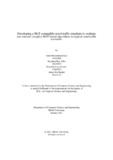| dc.contributor.advisor | Chakrabarty, Dr. Amitabha | |
| dc.contributor.author | Gazi, Sami Muhammad | |
| dc.contributor.author | Arko, Sayantan Roy | |
| dc.contributor.author | Gomes, Elizabeth Lina | |
| dc.contributor.author | Bin Shahid, Abrar | |
| dc.date.accessioned | 2022-11-15T08:59:08Z | |
| dc.date.available | 2022-11-15T08:59:08Z | |
| dc.date.copyright | 2021 | |
| dc.date.issued | 2021-01 | |
| dc.identifier.other | ID: 16341004 | |
| dc.identifier.other | ID: 16121013 | |
| dc.identifier.other | ID: 16121013 | |
| dc.identifier.other | ID: 17201073 | |
| dc.identifier.other | ID: 16121155 | |
| dc.identifier.uri | http://hdl.handle.net/10361/17573 | |
| dc.description | This thesis is submitted in partial fulfillment of the requirements for the degree of Bachelor of Science in Computer Science and Engineering, 2021. | en_US |
| dc.description | Cataloged from PDF version of thesis. | |
| dc.description | Includes bibliographical references (pages 42-45). | |
| dc.description.abstract | In recent years, Traffic Congestion has become a serious problem both for the devel oped and developing countries. Averting Traffic congestion’s preemptively would provide
maximum benefits to commuters all around. Wireless communication between vehicles,
which is nowadays accessible with smarter cars coming out more and more frequently,
is the right path in coming up with a solution for traffic congestion. Vehicular commu nications seek out to reduce congestion’s and improve road safety by adopting VANET
and IoT based solution systems. VANET systems create dynamic node-node connections
between vehicles to create a network of communication. SIoV promises new dimensions
to the traffic congestion issue of the world by introducing social network concepts to the
realm of SIoT, but this technology is still quite emerging. Therefore SIoT and the SIoT of
vehicles that is SIoV has only been explored in the hands of able simulators. This paper
proposes a novel Unity Engine based simulator to utilize complex SIoT traffic mapping
algorithms and simulate traffic scenarios once the connections between vehicles has been
established. Furthermore the simulator produces observations of the traffic congestion
judging from the vehicular connections, producing suggestions that help to avert further
traffic congestion’s for a 4-way intersection on a busy street. The simulator maps vehicles
as nodes and runs a scenario to observe the traffic scenarios created within the parame ters. The idea is to avoid traffic congestion by utilizing pre-existing concepts of SIoT and
design a simulator that can be fed SIoT algorithms and would produce satisfactory results. | en_US |
| dc.description.statementofresponsibility | Sami Muhammad Gazi | |
| dc.description.statementofresponsibility | Sayantan Roy Arko | |
| dc.description.statementofresponsibility | Elizabeth Lina Gomes | |
| dc.description.statementofresponsibility | Abrar Bin Shahid | |
| dc.format.extent | 45 Pages | |
| dc.language.iso | en_US | en_US |
| dc.publisher | Brac University | en_US |
| dc.rights | Brac University theses are protected by copyright. They may be viewed from this source for any purpose, but reproduction or distribution in any format is prohibited without written permission. | |
| dc.subject | SIoT | en_US |
| dc.subject | Traffic congestion | en_US |
| dc.subject | SIoV | en_US |
| dc.subject | Traffic Simulator | en_US |
| dc.subject | VANET | en_US |
| dc.subject | MANET | en_US |
| dc.subject | Unity | en_US |
| dc.subject | IoT | en_US |
| dc.subject | Gephi | en_US |
| dc.subject | SIoT Simulator | en_US |
| dc.subject | IoV | en_US |
| dc.subject | Social Networks. | en_US |
| dc.subject.lcsh | Internet of things | |
| dc.title | Developing a SIoT compatible novel traffic simulator to evaluate and execute complex SIoT based algorithms in typical road traffic scenarios | en_US |
| dc.type | Thesis | en_US |
| dc.contributor.department | Department of Computer Science and Engineering, Brac University | |
| dc.description.degree | B. Computer Science and Engineering | |

